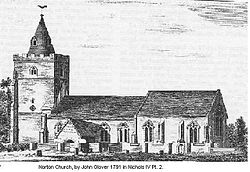
Twycross Zoo is a medium to large zoo near Norton Juxta Twycross, Leicestershire. The zoo has the largest collection of monkeys and apes in the Western World, and in 2006 re-launched itself as "Twycross Zoo – The World Primate Centre".

Twycross is a small village and civil parish in the Hinckley and Bosworth district, in Leicestershire, England, on the A444 road. Situated in the far west of the county and close to the North Warwickshire border, the population of the civil parish at the 2011 census was 850. The civil parish includes the villages of Norton Juxta Twycross and Orton on the Hill and the hamlets of Little Orton and Little Twycross, as well as Twycross Zoo, and the selective, private Twycross House School.

A clergy house is the residence, or former residence, of one or more priests or ministers of a given religion. Residences of this type can have a variety of names, such as manse, parsonage, rectory, or vicarage.
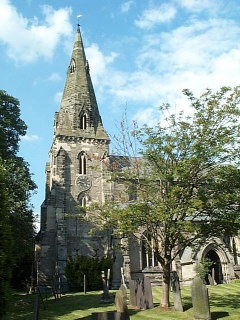
Austrey is a village and civil parish in the North Warwickshire District of Warwickshire, England.

Appleby Magna is a village and civil parish in the North West Leicestershire district, in the county of Leicestershire, England. It includes the small hamlets of Appleby Parva and Little Wigston.
Snarestone is a small rural village in North West Leicestershire, England.

Stretton en le Field is a small village and civil parish in the North West Leicestershire district of Leicestershire, England, about 7 miles/11 km south-west of Ashby de la Zouch, historically an exclave of Derbyshire. According to the 2001 census, the parish had a population of 36. At the 2011 census the population remained under 100 and so was included in the civil parish of Chilcote. Stretton Bridge carries the A444 road across the River Mease, which forms the northern parish boundary. It is among the Thankful Villages, suffering no Great War fatalities in 1914–1918: eleven men went from the village to fight and all returned.

Barsham is a village and civil parish in the East Suffolk district of the English county of Suffolk. It is about 2 miles (3.2 km) west of Beccles, south of the River Waveney on the edge of The Broads National Park. It is spread either side of the B1062 Beccles to Bungay road.

Appleby Parva, or Little Appleby, part of the parish of Appleby Magna in Leicestershire, is a hamlet about 1 mile (1.6 km) south-west of Appleby church. It straddles the A444, south of the crossroads of the highways from Ashby de la Zouch to Tamworth, from Atherstone to Burton upon Trent and Junction 11 of the M42/A42. Appleby Magna and Appleby Parva are usually collectively known as Appleby.
Richard Graves (1763–1829) was a Church of Ireland cleric, theological scholar and author of Graves on the Pentateuch. He was a Doctor of Divinity, one of the seven Senior Fellows of Trinity College, Dublin; a member of the Royal Irish Academy; Regius Professor of Greek (Dublin); and Dean of Ardagh. He was the younger brother of Thomas Ryder Graves, Dean of Ardfert and Connor.

Shenington is a village and former civil parish, now in the parish of Shenington with Alkerton, in the Cherwell district, in the county of Oxfordshire, England. It is about 5 miles (8 km) west of Banbury, it was an exclave of Gloucestershire until the Counties Act 1844 transferred it to Oxfordshire. Shenington is on Oxfordshire's boundary with Warwickshire. Shenington was an ancient parish of 1,628 acres (659 ha). In 1961 the parish had a population of 232. On 1 April 1970 the parish was abolished and merged with Alkerton to form "Shenington with Alkerton".
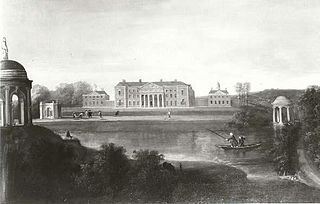
Gopsall is a former civil parish, now in the parish of Twycross, in the Hinckley and Bosworth district, in the county of Leicestershire, England. It is located between the villages of Appleby Magna, Shackerstone, Twycross and Snarestone. In 1931 the parish had a population of 13. Gopsall was formerly an extra-parochial tract, from 1858 Gopsall was a civil parish in its own right, on 1 April 1935 the parish was abolished and merged with Twycross.

Overseal is a village and civil parish in South Derbyshire district of Derbyshire, England. It is 3 miles (4.8 km) south of Swadlincote, 5 miles (8.0 km) west of Ashby-de-la-Zouch and 13 miles (21 km) south-southwest of Derby. It had a population of the civil parish at the 2011 census was 2,450. Situated within the National Forest area, it is near the villages of Netherseal and Lullington as well as being close to the border with Leicestershire. It is one of the southernmost settlements in Derbyshire.

The River Mease is a lowland clay river in the Midlands area of England. It flows through the counties of Leicestershire, Derbyshire and Staffordshire and forms the administrative border between these counties for parts of its length.
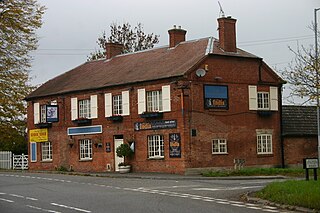
Elton on the Hill is a hamlet and civil parish in Nottinghamshire, England and within the Vale of Belvoir. A population of 114 was reported at the 2021 census.

White Roding is a village and civil parish in the Uttlesford district of Essex, England. The village is included in the eight hamlets and villages called The Rodings. White Roding is 8 miles (13 km) north-west from the county town of Chelmsford.

Godington is a village and civil parish about 5 miles (8 km) northeast of Bicester in Oxfordshire. The parish is bounded on all but the west side by a brook called the Birne, which at this point forms also the county boundary with Buckinghamshire. The parish was included in the figures of Stratton Audley for the purposes of the United Kingdom Census 2011.
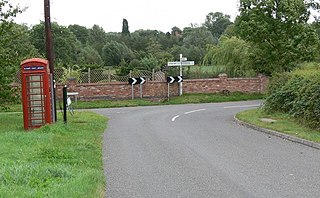
Bilstone is a small village and former civil parish, now in the parish of Shackerstone, in the Hinckley and Bosworth district of Leicestershire, England. It is approximately 12 miles (19 km) west from the county town and city of Leicester, and 2 miles (3.2 km) east from Twycross and the A444 road. In 1931 the parish had a population of 68.

St Michael and All Angels’ Church, Appleby Magna is a Grade II* listed parish church in the Church of England in Appleby Magna, Leicestershire


